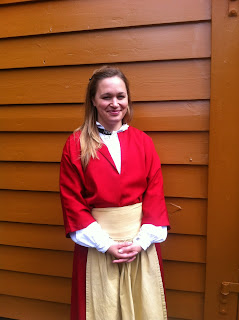July 6th
Eating out in Oslo is expensive. Our hotel provided free breakfast. That was a good deal from an economic standpoint. It was even better in terms of cuisine. Each morning I piled up heaps of smoked salmon alongside eggs and toast and bacon and coffee. Gail ate more sensibly. But even she was filled up by the time we got rolling. We both slept great, too. Neither one of us understood what we were looking at when we first entered our room. Two comforters were folded mysteriously on our bed. We didn't know what they were at first. Turns out, it was a great innovation. Gail didn't have to fight for the covers all night.
We hiked down to City Hall to begin the day. We joined a group for a guided tour, which included the history of the building and Oslo itself. Construction began after Norway became independent in 1905. The work was interrupted during World War Two. The murals reflected the occupation, although many of the paintings went far back in time and included a bunch of mythology too. The young hipster who led the tour was entertaining and taught us quite a bit about Norway's past.
From there we hopped over to the docks and boarded a transport to Bygdoy. We might have saved a kroner or two by taking the bus system. I can't figure out the bus system in Boston, let alone one that's written in Norwegian. Most of the passengers disembarked and headed straight to the Viking Museum. We decided to start with the Folk Museum. That really was a trip back through time. We toured a stave church and a number of restored farm houses and barns going all the way back into early 1700s. Seeing those helped us understand what Ramselia was all about when we visited there a few days later. The guides were in costume and answered whatever we asked. Music and dance performances sprang up throughout the property. There also was an interesting modern exhibit that revealed how city life changed during the twentieth century.
Then we walked to the Viking Museum. That was less of an extravaganza. But it contained two full size Viking ships that gave us an idea of how they operated. It wasn't until we reached Iceland later in our trip that we learned who the Vikings actually were. According to that story, in the 8th to 11th centuries Norwegians would pass down their farms to the oldest son. Any younger sons had to find some other way to earn a living. Some joined the Vikings, which was essentially a business organization -- not a nationality. Evidently, there is no evidence anywhere that Vikings wore helmets with horns on them. That is a Walt Disney invention.
Another walk took us to the Kon-Tiki Museum. We passed a beautiful neighborhood along the way. One house had a red clay tennis court with a couple of hotshots going at it. I'm a tennis player. So that caught my eye. The museum had the actual Kon-Tiki boat inside. Plus another ship that Thor Heyerdahl sailed from Africa to Barbados. Anthropologists doubt that either scenario took place in reality. The boats themselves were spectacular to look at, particularly the engineering. And while these days trips like that are a dime a dozen, in 1947 the expedition carried considerable risk. The excitement rubbed off on us.
The Fram Museum was next door. That held the actual ship used to explore the North Pole, then Antarctica too. The ship itself was fascinating. We were allowed to walk through the entire thing. The trips north were complicated and hard to fathom. There were written explanations but this was one place where a human guide would have been great. The Fram was incredibily strong, designed to withstand the pressures created by a sea of ice. The idea, from what I could gather, was to get caught in a glacier and ride it north.
Back in the harbor, Gail and I ate dinner at Lekter'n Lounge in the Aker Brygge section. The restaurant sat on a barge and gave us great views of the harbor. And of the thousands of people enjoying the area. Our waitress attended college in Oslo. She was from Italy originally. Almost everyone spoke excellent English. Even though most were pretty young they all seemed to have spent time in America, Australia, or other parts of Europe. The ones from America knew the slang better than we do! Let's hope the Brexit doesn't put a crimp in that mobility.

















































